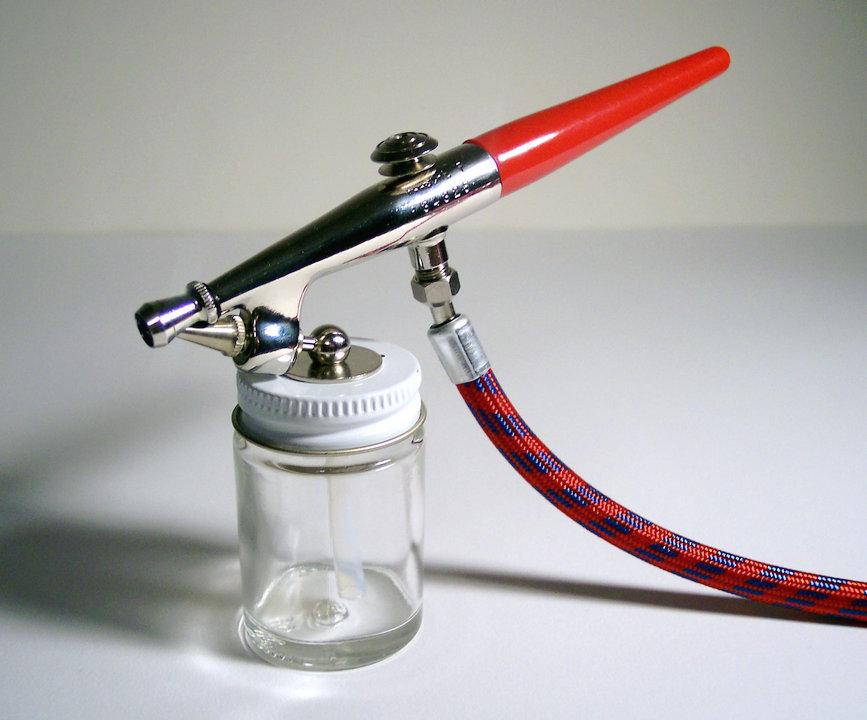

An airbrush is a small, air-operated tool that sprays various media, most often paint but also ink and dye, by a process of nebulization. Spray painting developed from the airbrush and is considered to employ a type of airbrush.
Since the inception of airbrush technology, commercial artists and illustrators realized airbrushes allowed them to create highly rendered images and a high level of realism. Artists often use the airbrush in combination with cut stencils or items held freehand to block in controlled manner the flow of paint onto the paper (or digital alternatives) with fantasy and science fiction artists. Airbrush images can be found today in advertising, publishing (e.g., book covers), comic books and graphic novels.
An airbrush works by passing a stream of fast moving (compressed) air through a venturi, which creates a local reduction in air pressure (suction) that allows paint to be pulled from an interconnected reservoir at normal atmospheric pressure. The high velocity of the air atomizes the paint into very tiny droplets as it blows past a very fine paint-metering component. The paint is carried onto paper or other surfaces. The operator controls the amount of paint using a variable trigger which opens more or less a very fine tapered needle that is the control element of the paint-metering component. An extremely fine degree of atomization is what allows an artist to create such smooth blending effects using the airbrush.
The technique allows for the blending of two or more colors in a seamless way, with one color slowly becoming another color. Freehand airbrushed images, without the aid of stencils or friskets, have a floating quality, with softly defined edges between colors, and between foreground and background colors. A skilled airbrush artist can produce paintings of photographic realism or can simulate almost any painting medium. Painting at this skill level involves supplementary tools, such as masks and friskets, and very careful planning.
Some airbrushes are capable of delivering a heavier coating more rapidly over a wide area. Even with small artist airbrushes using acrylic paint, artists must be careful not to breathe in the atomized paint, which floats in the air for minutes and can go deep into the lungs. With commercial spray guns for automobiles, it is vital that the painter have a clean air source to breathe, because automotive paint is far more harmful to the lungs than acrylic. Certain spray guns, called High-Volume Low-Pressure (HVLP) spray guns, are designed to deliver the same high volumes of paint without requiring such high pressures.
Airbrush technique is the freehand manipulation of the airbrush, medium, air pressure and distance from the surface being sprayed in order to produce a certain predictable result on a consistent basis with or without shields or stencils. Airbrush technique will differ with the type of airbrush being used.
Double-action airbrush technique involves depressing the trigger on the top of the airbrush with the index finger to release air only, and drawing it back gradually to the paint release threshold. The most important procedural dynamic is to always begin with air only and end with air only. By observing this rule, precise control of paint volume and line width and character can be achieved. The single most important airbrush stroke consistently utilized by professionals is the dagger stroke. This describes a stroke which begins wide and ends as a narrow line, created by starting with the brush far from the support and moving it evenly closer as the line is drawn.
Single-action airbrush technique derives its name from the fact that only one action is required for operation. The single action of depressing the trigger releases a fixed ratio of paint to air. Achieving different line widths requires either changing the tip and nozzle combination or else adjusting the spray volume manually between spray width changes. The most important aspect of proper single-action airbrush technique is to keep the hand moving before the trigger is depressed and after the trigger is released. This avoids the “bar bell” line.